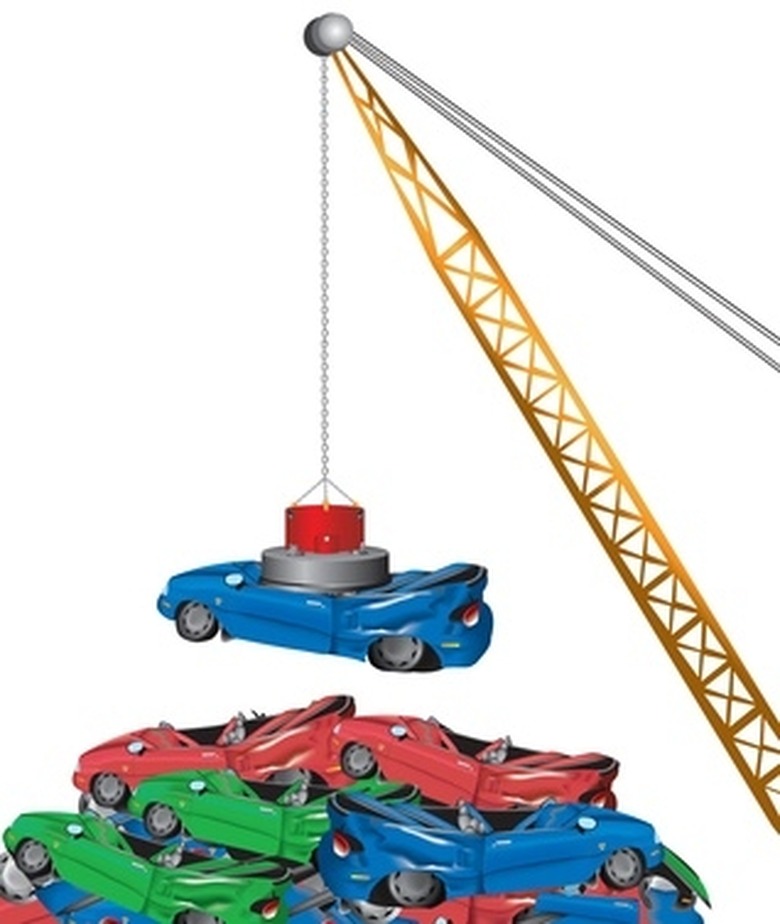How Is An Electromagnet Different From A Regular Bar Magnet?
Magnetism is a natural force that allows magnets to interact with other magnets, and certain metals, at a distance. Each magnet has two poles, named the "north" and "south" poles. Like magnetic poles push each other away and different poles pull each other closer. All magnets attract certain metals to them. There are two kinds of magnets. There are naturally occurring magnets and magnets made of electrical parts, called "electromagnets."
Link Between Electricity And Magnetism
Link Between Electricity And Magnetism
Electricity and magnetism, though seemingly two separate forces, are in fact closely interconnected. Discovered by the physicist Michael Faraday in the 19th century, the law of electromagnetic induction shows that moving electrical charges create magnetic fields. This is the basis for the existence of naturally occurring magnets and man-made electromagnets, according to Kristen Coyne of the National High Magnetic Field Laboratory.
Natural Magnets
Natural Magnets
With naturally occurring magnets, the current of moving electric charges that creates the magnetic field is generated inside the substance of the magnet. Atoms, the tiny particles that make up all physical objects, are made up out of charged electrons orbiting nuclear particles. Because the electrons are constantly moving around the nucleus, they are constantly creating magnetic fields.
Why Natural Magnets Have Magnetic Fields
Why Natural Magnets Have Magnetic Fields
In most materials the north and south poles of these tiny atomic magnets point every which way. This makes the effects of each cancel each other out, and the material is left nonmagnetic. In some materials, mostly metals, these tiny magnets line up and make the entire object magnetic.
Electromagnet Parts
Electromagnet Parts
An electromagnet is a device made up of three simple parts. A coil of wire is wound around a core of metal, usually iron. A battery or other power source is connected to the coil of wire. The wire is generally very thin and insulated by enamel, to further keep the size down.
How Electromagnets Work
How Electromagnets Work
When voltage is applied to the coil, then an electric current begins to flow through it. This causes a magnetic field to form around the wire. The coil shape forces the magnetic field of the current into a special configuration. All the fields of each loop of the coil line up so that the effect is that of a natural bar magnet. One end of the coil is a north pole and the other end is a south pole. The iron core reinforces the field of the wire, making the electromagnet stronger.
In Comparison
In Comparison
In many ways a natural magnet and an electromagnet are the same. Both are objects generating large magnetic fields out of electric currents. Both have a north and a south pole. However, an electromagnet can vary its strength (by varying its current) and a natural magnet cannot. An electromagnet can switch its poles (by reversing its voltage) while a natural magnet cannot. The field of a natural magnet is generated by many microscopic currents. The field of an electromagnet is generated by a single large-scale current.
Cite This Article
MLA
Thompson, Jason. "How Is An Electromagnet Different From A Regular Bar Magnet?" sciencing.com, https://www.sciencing.com/electromagnet-different-regular-bar-magnet-6386891/. 24 April 2017.
APA
Thompson, Jason. (2017, April 24). How Is An Electromagnet Different From A Regular Bar Magnet?. sciencing.com. Retrieved from https://www.sciencing.com/electromagnet-different-regular-bar-magnet-6386891/
Chicago
Thompson, Jason. How Is An Electromagnet Different From A Regular Bar Magnet? last modified August 30, 2022. https://www.sciencing.com/electromagnet-different-regular-bar-magnet-6386891/
